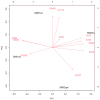First Insights into Bioaccumulation Patterns in Different Tissues of the Greenland Shark Somniosus microcephalus from Kulusuk (Southeastern Greenland)
- PMID: 40723415
- PMCID: PMC12292656
- DOI: 10.3390/biology14070857
First Insights into Bioaccumulation Patterns in Different Tissues of the Greenland Shark Somniosus microcephalus from Kulusuk (Southeastern Greenland)
Abstract
Marine environmental pollution has been rapidly increasing in Arctic waters, and the release and bioaccumulation of trace elements in Arctic marine species may pose significant risks to both ecosystem health and human well-being. As a top predator, the Greenland shark is an ideal sentinel species for ecotoxicological studies in this region. In this study, trace element analyses were conducted on various tissues from two Greenland sharks-a male and a female-collected in Kulusuk (southeastern Greenland). Eleven trace elements (Mn55, Co59, Cu63, Zn64, As75, Se82, Rb85, Mo98, Ag107, Cd112, and Pb208) were measured in different skin samples from both specimens and in the muscle and fat of the female using an Inductively Coupled Plasma Mass Spectrometer (ICP-MS). Principal Component Analyses (PCAs) revealed sex-related differences in skin bioaccumulation patterns, likely due to sampling of different skin regions. Notably, skin tissues from both sharks showed the highest concentration of trace elements, especially for As75 (9.39-41.13 ppm) and Zn64 (24.34-50.99 ppm) and with the exception of Ag107. These findings suggest that environmental exposure may play a more significant role than dietary intake in trace element accumulation in this area. This study represents the first investigation of trace element bioaccumulation in Greenland sharks from Kulusuk. While the results offer important preliminary insights into the species' ecotoxicology, further research involving more specimens and tissues is needed to confirm these trends. These initial findings contribute to filling key data gaps and have implications for both environmental monitoring and public health within the Greenlandic community.
Keywords: Arctic Ocean; Somniosus microcephalus; elasmobranch; environmental pollution; trace elements.
Conflict of interest statement
The authors declare no conflicts of interest.
Figures





References
-
- Gallo S., Leonetti F.L., Reinero F.R., Micarelli P., Passarelli L., Giglio G., Milazzo C., Imbrogno S., Barca D., Bottaro M., et al. Bioaccumulation patterns in different tissues of twelve species of elasmobranchs from the Tyrrhenian and Ionian Sea (Calabria, Southern Italy) Environments. 2025;12:12. doi: 10.3390/environments12010012. - DOI
-
- Reinero F.R., Milazzo C., Minervino M., Marchio C., Filice M., Bevacqua L., Giglio G., Leonetti F.L., Micarelli P., Tripepi S., et al. Parasitic load, hematological parameters, and trace elements accumulation in the lesser spotted dogfish Scyliorhinus canicula from the Central Tyrrhenian Sea. Biology. 2022;11:663. doi: 10.3390/biology11050663. - DOI - PMC - PubMed
LinkOut - more resources
Full Text Sources
Research Materials

